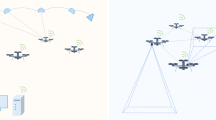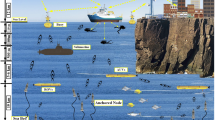Abstract
Interference and jamming become crucial issues in swarm robot communication and sensing, especially in underwater applications. In this paper, an algorithm for facilitating scheduling within robotic swarm is formulated and its investigation in a series of experiments is described. The scheduling algorithm is biologically inspired by the firefly and frog. Novel distributed models for both algorithms are also investigated to improve scalability and provide decentralization of the algorithms. It is proven from the simulated experiments that the model is robust and viable for scheduling underwater swarm communication and sensing. Moreover, the paper illustrates that global swarm cognition can also be achieved using the algorithm to estimate the swarm density in a decentralized way. Finally, a real robot experiment using underwater swarm robot platforms is also presented.










Similar content being viewed by others
References
Schmickl et al. (2011) CoCoRo: the self-aware underwater swarm. In: IEEE Proceeding on SASO (self adaptive and self organized)
Cocoro, see http://cocoro.uni-graz.at/drupal/
Sutantyo D, Levi P, Moeslinger C, Read M (2013) Collective-adaptive lévy flight for underwater multi-robot exploration. IEEE Int Conf Mech Automat
Tyrrell A, Auer G, Bettstetter C (2006) Fireflies as role models for synchronization in ad hoc networks. In: Proceeding of the bio-inspired models of network, information and computing systems
Tyrrell A, Auer G, Bettstetter C (2008) On the accuracy of firefly synchronization with delays. In: Proceedings IEEE international symposium on applied sciences in biomedical and communication technologies (ISABEL), Aalborg, Denmark
Mirollo RE, Strogatz SH (1990) Synchronization of pulse coupled biological oscillators. SIAM J Appl Math 50(6):1645–1662
Strogatz S, Stewart I (1993) Coupled oscillators and biological synchronizatione. Sci Am 269(6):6874
Werner-Allen G, Tewari G, Patel A, Welsh M, Nagpal R (2005) Firefly-inspired sensor network synchronicity with realistic radio effects, SenSys05. California, USA
Mutazono A, Sugano M, Murata M (2009) Frog call-inspired self-organizing anti-phase synchronization for wireless sensor networks. 2nd international workshop on nonlinear dynamics and synchronization (2009)
Aihara I, Kitahata H, Yoshikawa K, Aihara K (2008) Mathematical modelling of frogs’ calling behavior and its possible application to artifical life and robotics. Proc Artif Life Robot
Hernandez H, Blum C (2009) Distributed graph coloring: an approach based on the calling behavior of Japanese tree frogs. Proc Swarm Intell
Hernandez H, Blum C (2011) Distributed graph coloring in wireless ad hoc networks: a light-weight algorithm based on Japanese tree frogs calling behaviour. In: Proceeding of wireless and mobile networking conference (WMNC) (2011)
Ermentrout B (1991) An adaptive model for synchrony in the firefly pteroptyx malaccae. J Math Biol 29(6):571–585
Sutantyo D, Levi P (2013) Towards synchronized communication and sensing in robotic swarms. Accepted to be published on Int J Intell Mechatron Robot 3(4)
Nishida T, Inoue S, Sagara S (2013) State estimation of mobile robot using GPS signal that includes reflected and diffracted waves. J Artif Life Robot 18(3–4):178–186
Read M, Moeslinger C, Dipper T, Kengyel D, Hilder J, Thenius R, Tyrrell A, Timmis J, Schmickl T (2013) Profiling underwater swarm robotic shoaling performance using simulation. Towards Auton Robot Syst (TAROS)
Sutantyo D, Levi P (2013) A bio-inspired TDMA scheduling algorithm for underwater robotic swarms. Robot Biomimet (ROBIO), 2013 IEEE international conference on, pp 1107–1112
Somaraju R, Schill F (2007) Communication module and TDMA scheduling for a swarm of small submarines. Tr. J. of Electrical Engineering and Computer Sciences, Special Issue on Swarm Robotics
Schill F, Zimmer UR, Trumpf J (2005) Towards optimal TDMA scheduling for robotic swarm communication. In: Proceeding of towards autonomous robotic and system
Kim SG, Taguchi S, Hong SI, Lee HH (2014) Cooperative behavior control of robot group using stress antibody allotment reward. J Artif Life Robot 19(1):16–21
Strogatz SH, Marcus CM, Westerveld RM, Mirollo RE (1989) Collective dynamics of coupled oscillators with random pinning. Physics, 36:441–425
Acknowledgments
This work is supported by EU Projects CoCoRo (Collective and Cognitive Robotic, the Grant agreement No. 270382). Additionally, we want to thank all members of the projects for fruitful discussions.
Author information
Authors and Affiliations
Corresponding author
Additional information
This work was presented in part at the 19th International Symposium on Artificial Life and Robotics, Beppu, Oita, January 22–24, 2014.
About this article
Cite this article
Sutantyo, D., Levi, P. Decentralized underwater multi-robot communication using bio-inspired approaches. Artif Life Robotics 20, 152–158 (2015). https://doi.org/10.1007/s10015-015-0201-5
Received:
Accepted:
Published:
Issue Date:
DOI: https://doi.org/10.1007/s10015-015-0201-5




